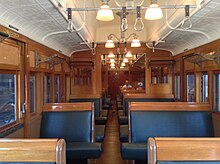Tait (train)
| Tait carriages | |
|---|---|

A Tait at Newport Workshops in 2014
|
|

The interior of a tait restored by ElecRail.
|
|
| Designer | Victorian Railways |
| Assembly | Victorian Railways |
| Built at | Newport Railway Workshops |
| Replaced | Steam-hauled carriages |
| Constructed | 1910-1953 |
| Entered service | 1910 (as locomotive-hauled carriages) 1919 (as EMU cars) |
| Scrapped | 1974-1984 |
| Number built | 623 |
| Fleet numbers | 201-461M (motor cars), 470-473M (double ended motor cars) 201-265D (driving trailers), 201-372T & 380-442T (trailer cars) 1-103G (dual lighting trailers) |
| Operator(s) |
Victorian Railways (1910-1983) Metropolitan Transit Authority (1983-1984) |
| Depot(s) | Jolimont Workshops |
| Line(s) served | All Melbourne Suburban |
| Specifications | |
| Car body construction | 59 ft 9 in (18.21 m) |
| Car length | 61 ft 8 1⁄2 in (18.81 m) |
| Width | 9 ft 6 in (2.90 m) |
| Height | 11 ft 8 7⁄8 in (3.58 m) |
| Wheelbase | 50 ft (15.24 m) |
| Maximum speed | 50 mph (80 km/h) |
| Weight |
M cars: 47 LT 16 cwt 0 qtr (48.57 t) (clerestory roof) |
| Traction motors | 4 x 105 kW (141 hp) GE239 |
| Electric system(s) | 1500 V DC overhead lines |
| Wheels driven | All on Motor carriages (ACPM, BCPM, M & CM) |
| Bogies | 8 ft (2.44 m) |
| Braking system(s) | Westinghouse |
| Coupling system | Screw |
| Track gauge | 5 ft 3 in (1,600 mm) |
| Overview | |
|---|---|
| Status | Ceased |
| First service | March 1936 |
| Last service | October 1939 |
| Current operator(s) | Victorian Railways |
| Route | |
| Start | Flinders Street Station |
| End | Port Melbourne |
M cars: 47 LT 16 cwt 0 qtr (48.57 t) (clerestory roof)
M cars: 50 LT 4 cwt 0 qtr (51.01 t) (curved roof)
CM cars: 49 LT 8 cwt 0 qtr (50.19 t) (clerestory roof)
D cars: 27 LT 10 cwt 0 qtr (27.94 t)
T & G cars: 26 LT 10 cwt 0 qtr (26.93 t)
The Tait trains were a wooden bodied Electric Multiple Unit train that operated on the suburban railway network of Melbourne, Victoria, Australia. They were introduced in 1910 by the Victorian Railways as steam locomotive hauled cars, and converted to electric traction from 1919 when the Melbourne electrification project was underway. The trains derived their name from Sir Thomas James Tait, the chairman of commissioners of the Victorian Railways from 1903 to 1910. The first cars were built during 1909 with the last entering service in 1951.
The trains were initially known as "Sliding Door" trains, as opposed to the Swing Door then in service. They were later known as "Reds" or "Red rattlers" from the 1950s when the blue-painted Harris trains were introduced.
Tait trains had a partly open saloon layout, with bench seats running across the train, the saloon being divided by partitions into a number of smaller areas. Each seating aisle was provided with its own exterior sliding door.
Incandescent lighting, a ceiling with pressed tin patterns, luggage racks above head height, and beautifully stained woodgrain walls were fitted inside each compartment. Interiors were split into smoking and no-smoking compartments until late 1978 with the abolition of smoking on trains, and carriages were designated as first or second class until 1958 when one class suburban travel was introduced.
The exterior of the trains were of two main styles: the original cars had a clerestory roof, and those built from the late 1920s onward had a simpler arched roof.
From 1971 the interior was simplified to cut maintenance costs, with some doorway windows being replaced by metal and plywood, and the wooden latticed sun blinds being removed. The motor bogies on the trains were originally of pressed steel construction, being changed for a new design in cast steel in the 1930s.
...
Wikipedia
